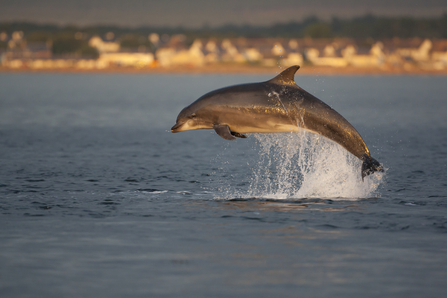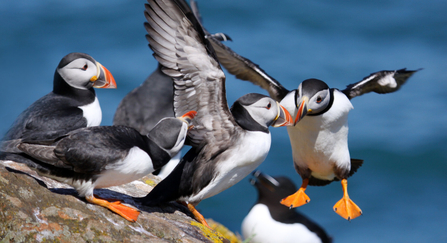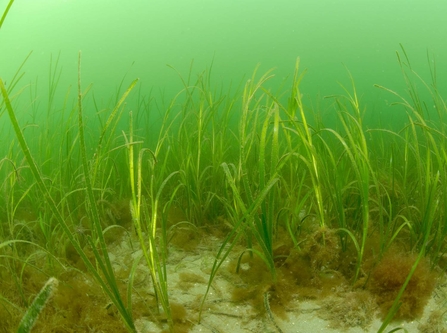The highs and lows from the shores of the UK, Alderney and Isle of Man in 2022 include:
- A new species of coral, a 100-year-old shark, orca calves and a very special albatross
- Avian flu, plastic and oil pollution, and reckless tourists pile pressure on marine life
- Seagrass success, a puffin phenomenon and new generation of ocean champions
Dr Lissa Batey, head of marine conservation at The Wildlife Trusts, says:
“From ancient sea creatures to new species for science, the discoveries in this year’s marine review show just how spectacular life is below the waves.
“While full of surprises, our oceans are also busy places where wildlife is facing a huge range of pressures – including climate change, pollution and development. The sea needs better protections to help nature recover and thrive as a matter of urgency. That must start with the Government abandoning the dangerous Retained EU Law Bill which threatens to rip up existing laws that protect wildlife and wild places both on land and at sea.
“Protecting large areas of our oceans is crucial for fishing and other industries that rely on healthy seas, as well as providing security for important carbon storing habitats like seagrass meadows and seabed sediments.”
Extraordinary wildlife sightings highlight diversity and mystery of UK seas
Research, monitoring and advances in technology have enabled scientists to uncover a wealth of new information about marine life. Exciting discoveries show how much there is still to learn about UK seas and why legal protections are vital for wildlife and climate...
- A new species of deep-sea coral, Pseudumbellula scotiae, was discovered 240 miles off Scotland’s west coast. Found at depths of up to 2,000m in the Rockall Trough, it is completely new to science. The find is a sign of undisturbed natural habitat and shows why bottom-trawling must be banned to protect marine life.
- A 100-year-old Greenland shark washed up at Newlyn in Cornwall – the second ever UK stranding of this species. These creatures have the longest lifespan of all vertebrates, making them vulnerable to overfishing. Protecting large areas of ocean is key to the future of long-living marine life.
- Leicester and Rutland Wildlife discovered the fossilised remains of Britain's largest ichthyosaur – a prehistoric sea creature known as a ‘Sea Dragon’. News of the find was shared with the world in January.
- A black-browed albatross returned to Bempton cliffs in Yorkshire. 'Albie' is believed to be the only albatross in the Northern Hemisphere and the same bird that blew off course in 1967.
- Volunteers with Cornwall Wildlife Trust discovered Babakina anadoni – a type of sea slug – the first official record of this species in UK waters. Another sea slug, Corambe testudinaria, usually found near the French coast, was recorded off the UK for the first time.
- Manx Wildlife Trust recorded the first ever swordfish off the Isle of Man. They are typically found in tropical waters of the mid-Atlantic, Pacific and Mediterranean.
- Cetaceans continued to delight observers with records of bottlenose, common, white-sided and Risso’s dolphins, and harbour porpoise around the UK. Sightings of pilot, fin, minke and humpback whales show how populations are recovering following bans on commercial whaling, for example:
- Two new orca calves were spotted off Shetland in January, a positive sign for the Northern Isles community pod.
- Volunteers recorded a large group of minke whales, normally solitary animals, gathering off the Yorkshire coast in August. Over 80 sightings were recorded in one morning. In very rare sightings for the region, Cumbria Wildlife Trust reported minke whales near its Walney Island nature reserve and off the coast of Workington.
- Cornwall Wildlife Trust recorded a stranded Atlantic white-sided dolphin – the first time one has stranded in the UK in over 10 years.
- Monitoring by Yorkshire Wildlife Trust suggests bottlenose dolphins are now present off Yorkshire year-round. Dolphins found off Scotland commonly visit Yorkshire’s coast to feed in summer, but it’s thought they are now increasingly visiting in winter.
- There were plenty of sightings of humpback whales – including a young calf seen near the Lizard peninsula in Cornwall. More than 75 humpbacks have been recorded by Cornwall Wildlife Trust since 2019. Sussex Wildlife Trust also recorded a humpback sighting near Brighton Marina.
- In the summer, Cornwall Wildlife Trust reported huge numbers of octopus around the Lizard Peninsula. Experts believe it is the sign of a healthy population and possible octopus boom, an event last recorded over 70 years ago.



